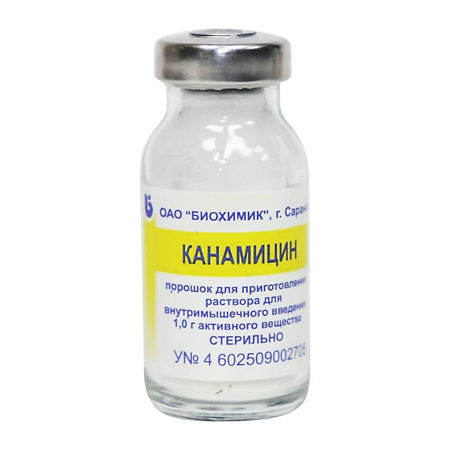No products in the cart.
Kanamycin 1 g
€1.00
Out of stock
(E-mail when Stock is available)
SKU: 243468
Categories: Antibiotics, Medicine
Description
A broad-spectrum aminoglycoside antibiotic produced by Streptomyces kanamyceticus. It has a bactericidal effect.
Active against Mycobacterium tuberculosis, Gram-negative bacteria: Escherichia coli, Shigella spp., Salmonella spp., Proteus spp., Enterobacter spp, Klebsiella pneumoniae, Neisseria gonorrhoeae, Neisseria meningitidis; Gram-positive cocci: Staphylococcus spp. (including strains producing penicillinase).
Pseudomonas spp., Streptococcus spp. are little or resistant to kanamycin.
Kanamycin is resistant to anaerobic bacteria, yeasts, viruses and most protozoa.
Indications
Indications
Treatment of the following diseases and conditions:
severe purulent-septic diseases (sepsis, meningitis, peritonitis, septic endocarditis);
infectious and inflammatory diseases of the respiratory system (pneumonia, pleural empyema, lung abscess);
kidney and urinary tract infections (pyelonephritis, cystitis, urethritis);
purulent complications in the postoperative period;
infected burns and other diseases caused predominantly by gram-negative microorganisms. (E. coli, Enterobacter aerogenes, Serratia, Salmonella, Klebsiella pneumonia, Proteus spp., Shigella), resistant to other antibiotics, or associations of gram-positive and gram-negative pathogens;
pulmonary tuberculosis and tuberculous lesions of other organs caused by Mycobacterium tuberculosis resistant to first and second line anti-tuberculosis drugs and other anti-tuberculosis drugs, except florimycin.
Pharmacological effect
Pharmacological effect
Broad-spectrum aminoglycoside antibiotic produced by Streptomyces kanamyceticus. Has a bactericidal effect.
Active against Mycobacterium tuberculosis, gram-negative bacteria: Escherichia coli, Shigella spp., Salmonella spp., Proteus spp., Enterobacter spp., Klebsiella pneumoniae, Neisseria gonorrhoeae, Neisseria meningitidis; gram-positive cocci: Staphylococcus spp. (including strains producing penicillinase).
Pseudomonas spp., Streptococcus spp. are insensitive or resistant to kanamycin.
Anaerobic bacteria, yeast, viruses and most protozoa are resistant to kanamycin.
Special instructions
Special instructions
During the treatment period, it is necessary to monitor the function of the kidneys, auditory nerve and vestibular apparatus at least once a week.
The likelihood of developing nephrotoxicity is higher in patients with impaired renal function, as well as when prescribing high doses or for a long time (in these patients, daily monitoring of renal function may be required).
If audiometric tests are unsatisfactory, the dose of the drug is reduced or treatment is stopped.
Aminoglycosides pass into breast milk in small quantities (since they are poorly absorbed from the gastrointestinal tract, no complications associated with them have been reported in infants).
Patients with infectious and inflammatory diseases of the urinary tract are recommended to take increased amounts of fluid.
In the absence of positive clinical dynamics, one should remember the possibility of the development of resistance of microorganisms. In such cases, it is necessary to discontinue treatment and begin appropriate therapy.
Active ingredient
Active ingredient
Kanamycin
Composition
Composition
Kanamycin (in the form of monosulfate) – 1 g.
Contraindications
Contraindications
hypersensitivity (including a history of other aminoglycosides);
severe chronic renal failure with azotemia and uremia;
neuritis of the VIII pair of cranial nerves;
pregnancy.
With caution: myasthenia gravis, parkinsonism, botulism (aminoglycosides can cause disruption of neuromuscular transmission, which leads to further weakening of skeletal muscles), renal failure, old age, premature babies, neonatal period (up to 1 month), lactation period.
Side Effects
Side Effects
From the gastrointestinal tract: nausea, vomiting, diarrhea, liver dysfunction (increased activity of liver transaminases, hyperbilirubinemia).
From the hematopoietic organs: anemia, leukopenia, granulocytopenia, thrombocytopenia.
From the nervous system: headache, drowsiness, weakness, neurotoxic effect (muscle twitching, numbness, tingling, paresthesia, epileptic seizures), possible disruption of neuromuscular transmission.
From the senses: ototoxicity (ringing or a feeling of congestion in the ears, hearing loss up to irreversible deafness), toxic effects on the vestibular apparatus (discoordination of movements, dizziness, nausea, vomiting).
From the urinary system: nephrotoxicity – impaired renal function (increase or decrease in frequency of urination, thirst, cylindruria, microhematuria, albuminuria).
Allergic reactions: skin rash, itching, skin hyperemia, fever, Quincke’s edema.
Interaction
Interaction
Pharmaceutically incompatible with streptomycin, gentamicin, monomycin, penicillins, heparin, cephalosporins, capreomycin, amphotericin B, erythromycin, nitrofurantoin.
Nalidixic acid, polymyxins, cisplatin and vancomycin increase the risk of developing oto- and nephrotoxicity.
Diuretics (especially furosemide), cephalosporins, penicillins, sulfonamides and NSAIDs, competing for active secretion in the nephron tubules, block the elimination of aminoglycosides, increase their concentration in the blood serum, increasing nephro- and neurotoxicity.
Parenteral administration of indomethacin increases the risk of developing the toxic effect of kanamycin (increased T1/2 and decreased clearance).
Reduces the effect of antimyasthenic drugs. Enhances the muscle relaxant effect of curare-like drugs, general anesthetics and polymyxins.
Methoxyflurane, polymyxins for parenteral administration and other drugs that block neuromuscular transmission (halogenated hydrocarbons as drugs for inhalation anesthesia, opioid analgesics), transfusion of large amounts of blood with citrate preservatives increase the risk of respiratory arrest (as a result of increased neuromuscular blockade).
Overdose
Overdose
Symptoms: toxic reactions (hearing loss, ataxia, dizziness, urinary disorders, thirst, anorexia, nausea, vomiting, ringing or a feeling of congestion in the ears, breathing problems).
Treatment: to relieve the blockade of neuromuscular transmission and its consequences – hemodialysis or peritoneal dialysis, the appointment of anticholinesterase drugs, calcium salts, mechanical ventilation, symptomatic and supportive therapy.
Storage conditions
Storage conditions
In a place protected from light, at a temperature not exceeding 25 °C.
Keep out of the reach of children.
Shelf life
Shelf life
2 years.
Manufacturer
Manufacturer
Biokhimik JSC, Russia
Additional information
| Shelf life | 2 years. |
|---|---|
| Conditions of storage | In the dark place at a temperature not exceeding 25 °C. Store out of the reach of children. |
| Manufacturer | Biokhimik JSC, Russia |
| Medication form | solution for injection |
| Brand | Biokhimik JSC |
Related products
Buy Kanamycin 1 g with delivery to USA, UK, Europe and over 120 other countries.














